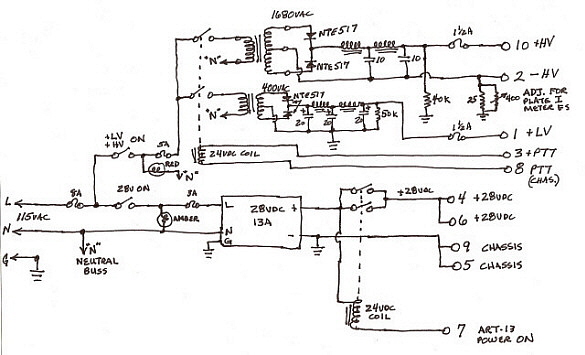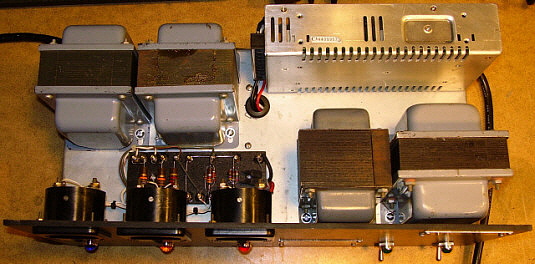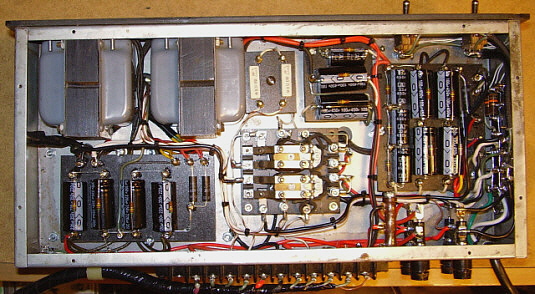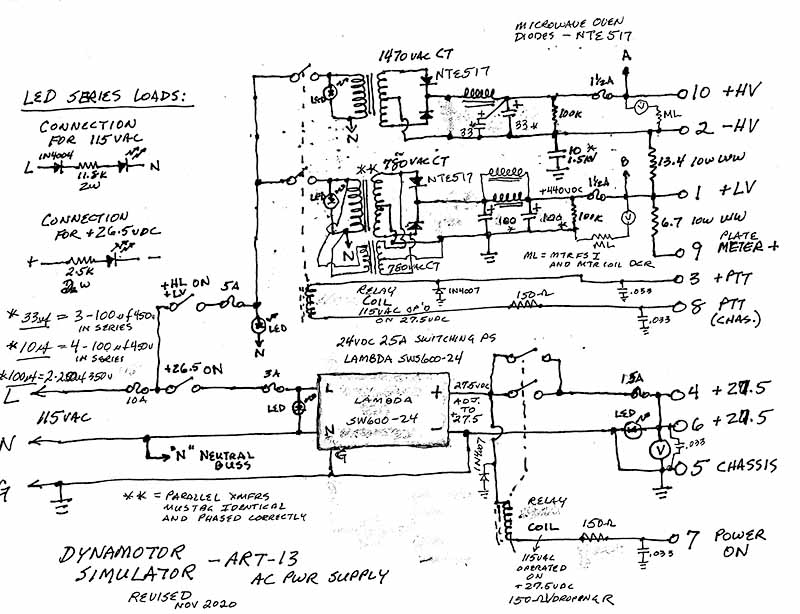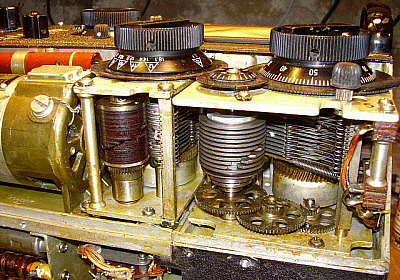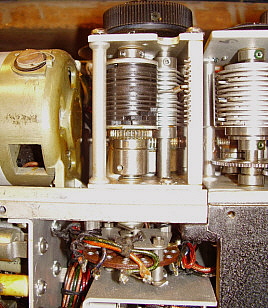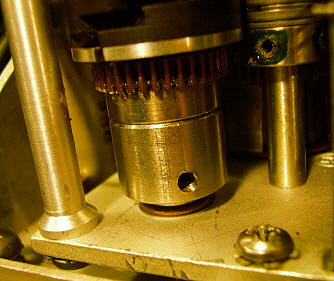| For many months now, every few weeks I've been switching
in and out of the operating position one of my two ART-13 transmitters
because only one AC power supply was available. After I finished the
restoration of the ART-13A "Basket Case," I didn't design and build a
power supply for it. This situation needed to change. I decided that I
didn't want to go the huge, immoveable type of power supply but that I
would rather design a power supply that was small and lightweight. I
wasn't concerned about maximum power output since I had the "Hommage a
le Valve" power supply that easily allowed running 150 watts output from
the transmitter. This new power supply would be like the dynamotor in
that two lower voltage supplies would be connected in series to provide
the +HV and I would shoot for about +1150vdc as the dynamotor supplied.
The original dynamotor circuit provided +400vdc for the +LV and +750vdc
(+HV) in series with the +LV to achieve +1150vdc plate voltage. A
barometric pressure switch separated the two supplies above 25,000 feet
altitude to prevent arc-over by reducing the plate voltage to +750vdc.
It is very easy to use this same approach in designing an AC operated
power supply, excluding the barometric pressure switch, of course. The
advantages are that the components used will be rated at lower voltages
which reduces expense and generally makes locating them easier. One
thing to keep in mind is that the +LV supply must be able to handle not
only its own current requirements but must also be able to carry the
current required by the +HV since the negative return for the +HV is
connected to the +LV and then to chassis. This means that the +LV will
have to be capable of about 500mA maximum current. The original
dynamotor spec for the +LV is 750mA but this is the dynamotor capability
not the actual +LV current requirement of the ART-13.
To handle the additional current the +LV transformers are actually
two identical transformers that are connected in parallel. When
operating transformers in this manner they must be exactly the same,...
identical. Also, their connections must be "phased." This means that
primary and the secondary windings must be connected so the AC applied
and the AC output are in phase in each transformer. This is easy to test
ahead of the building and mark the primary and secondary windings so
there will be no confusion at assembly time. I only used the parallel
transformers because I didn't have a single 400-0-400vac that had enough
current capacity for the +LV (+LV and +HV current combined) requirement. If you can find a 500mA rated
transformer then going with the single, although large, transformer is
much easier. Same reason for the parallel chokes in the +LV supply.
There are some changes that have to be made in the general design
that allows for the proper operation of the Plate Current meter since
the -HV is connected to +LV. This is basically done by providing a
bridge circuit using a 13.4 ohm series load from -HV (negative meter
connection) to pin 1 (+LV) and a 6.7 ohm series load from pin 1 (+LV) to
pin 9 of U7 (positive meter connection.) This duplicates the circuit
used in the original dynamotor. The advantage to this bridge resistor
set up is that the Plate Current meter reads accurately regardless of
the actual level of +HV and +LV as long as the ratio of +HV to +LV
remains approximately 2:1 (actually, the ratio of +750 to +400 is 1.87:1
but the bridge resistor ratio is 2:1.)
Since a minimum of +750vdc is used for +HV, the filter capacitors
can be series-connected 100uf 450wvdc type electrolytics with 510K
resistors across each cap to equalize the voltage drop across the series
connections. Three capacitors are used resulting in a working voltage of
about 1350vdc at a capacitance of about 33uf. Since we are using
Pi-filtering, in an "unloaded" condition the +HV could soar to around
+1035vdc.The extra "head-room" is protection in case the power supply is
operated without a load. The same type of "head-room" is used in the +LV
section, where the unloaded voltage could rise to around +600vdc. Using
two series-connected 350wvdc electrolytics results in around +700vdc
capability. In normal operation, the power supply design is such that
the +HV and +LV are actuated with the PTT from the ART-13 which would
also be in the powered-up condition thus presenting full load to both
the +HV and +LV instantly. However, in some testing situations (or
perhaps in an ART-13 failure mode) the power supply might be operated
"lightly loaded" (or "unloaded") and this capacitor "hook-up" gives us
the necessary head-room to survive this possibility without component
damage to the power supply.
Solid-state microwave oven type diodes can be used in both supplies
connected as full-wave rectifiers. These diodes are type NTE517 rated at
15kv PIV. These diodes are relatively expensive at about $8.00 each. The
advantage of SS diodes is higher output voltage from the power supplies.
To take advantage of the smaller size and lighter weight
possibilities, a 24vdc 13 amp Meanwell Switching Power Supply is used
for the +28vdc requirements. This supply can be adjusted up to +27.0vdc
maximum which will provide sufficient voltage to operate the filaments,
relays and the Autotune. Though the Meanwell PS is RFI quite as a
+27.0vdc source for the ART-13, it can cause interference in receivers
unless the cable from the power supply to the ART-13 is fully shielded.
NOTE: I used the Meanwell PS for several years without any
serious problems. But, I noticed that when operating 630M with the
receiver on a loop antenna, I could pick up some noise being generated
by the Meanwell PS. HF didn't seem to pick up the noise, just MW. There were other issues with a switching spike on
the transmitter output (not audible but seen on a 'scope.) Also, the Meanwell PS would "drop out" on initial power up causing the ART-13 to
"chatter" for a few cycles before it would become stable. I eventually
rebuilt the Dyna-Sim to use an external +28vdc 25A Lambda linear power
supply to correct the problems that were caused by the Meanwell PS.
8-3-20. This power supply also had some issues in that it would "trip
its breaker" when PTT was actuated or released. After a ten minute
warm-up, the "tripping" was only an occasional nuisance.
NOTE: Nov. 26, 2020 - I purchased a Lambda 24vdc 25A
switching power supply. It's twice as wide as the Meanwell, slightly
taller but about the same length. I've
installed it onto the Dyna-Sim chassis where the Meanwell had been mounted.
All wiring changes that were made for the external power supply were returned to
original for internal connections to the new Lambda. A few
different "vent holes" had to be cut into the cabinet since the Lambda fan
is in a different location than the Meanwell's was and it's larger size
required a top vent to allow air intake. The Lambda was
mounted using two aluminum brackets rather than mounting the power
supply directly onto the chassis.
This was to make installation easier and not require major disassembly
of the underneath of the Dyna-Sim. The new Lambda easily adjusts up to over +30vdc output. I
set the voltage output to +27.5vdc. The schematic of the Dyna-Sim
shown to the lower right is the latest revision from November 26, 2020.
|
>>> I decided to build the Dyna-Sim into a BC-348 cabinet. This cabinet
had been destroyed by a former owner who drilled out all of the pop
rivets that mount the bottom plate which has all of the engagement pins
for the shock mount. Rubber feet were installed to take the place of the
engagement pins, thus ruining the cabinet for proper use with a BC-348
and FT-154 shock mount. The back of the cabinet had have a wide
rectangular opening cut to provide access to the fuses, line cord and
the output terminal strip. A round hole was also cut to provide
ventilation for the fan in the Meanwell PS. The front panel is made from
type of black hard plastic called delrin. Three panel meters are
provided to allow constant monitoring of the output voltages during
operation.
As with the "Hommage a le Valve" power supply, the only reason
I used three meters is because I found three matching meters in the junk
box. Setting up any DC current meter to act as a DC voltage reading
meter is quite easy and only involves knowing the meter coil resistance,
the meter full scale current requirement and then calculating a series
dropping resistor based on the supply voltage to be measured versus the
FS voltage scaling desired. For example, if the meter to be used is a
1mA FS DC Current meter and it is going to be used to measure the
+400vdc and the FS DC voltage scaling desired is +1000vdc. The DCR of
the meter coil in a 1MA FS meter is usually around 50 ohms (but measure
it to be exact when actually doing your calculation.) Since the meter is
1mA FS, the total current through the series dropping resistor and the
meter will be 1mA. The meter coil resistance is 50 ohms, so E = I/R
indicates that the voltage drop across the meter at FS will be
.00002vdc. FS DC voltage will be 1000vdc, so 1000 - .00002 = 999.99998
drop required in the series resistor. R=E/I so 999.99998/.001 =
999,999.98 ohms. You might as well use a 1 meg resistor. Dissipation
equals I² x R = P or (.001 x .001) x 1,000,000 = 1.0 watt. 2X the
dissipation is standard practice and allows the resistor to operate in
the middle of its rating. So, a 1 meg ohm 2 watt resistor can be used
and the 1mA DC Current meter will read accurately the +400vdc at .4mA on
the scale. You can usually alter the actual meter scale so that
"MILLIAMPS" is painted over and leave the "DC." If you have suitable
"rub-on" lettering, you can add "VOLTS" to complete the meter
transformation. To take advantage of the existing meter scale, the +HV
meter actually indicates the +700vdc supply measured to -HV rather than
measuring to chassis which would indicate +HV plus +LV, or the actual
voltage (~ +1100vdc) applied to the 813 and two 811 plates.
Two 24vdc relays are required for the PTT and
Power On functions. The junk box turned up a very nice heavy-duty dual
relay with 0.25" contacts. The problem was that the coils were for
115vac operation. Since these are solenoid coils, the operation doesn't
really change whether AC or DC voltage is used. When using DCV on an ACV
rated coil, you will have to significantly reduce the voltage. In testing the
relay, it was found that good switching occurs with about 15vdc. A 150
ohm dropping resistor in series with the +27vdc supply provided around
+18vdc to the relay and allowed fast, positive switching.
A construction technique employed in the Dyna-Sim is the use of
"component boards." The boards were made of 3/16" thick delrin and the
terminals were made from 4-40FH brass screws secured with brass nuts.
The use of brass allowed soldering directly to the terminal stud.
Unfortunately, component boards require a lot of planning for proper
layout and routing of the wiring (which is via a harness.) This prolongs
the design phase and ends up with the project taking much longer to
complete. If you're in a hurry then the use of standard tie points is
easier and allows for quick construction. The upside of component boards
is that the appearance of the wiring and construction looks like a
professional job. See photos below of the finished Dyna-Sim.
+750vdc (+HV) - This
is supplied by a 1475vac CT Plate transformer rated at .25A. Since no
other windings are on the frame, this transformer is relatively small.
Pi-filtered. Actual voltage is close to +900vdc under load. Total +HV is
approximately +1300vdc. NOTE: This was changed to a choke input filter for
better voltage stability under load. This reduced to voltage to about
+700vdc with the resulting total being about +1100vdc. 8-3-20
+400vdc (+LV) - This
is supplied by two identical parallel-connected 780vac CT Power
Transformers and two identical parallel connected filter chokes. Actual
voltage is around +440vdc under load. Total current available is 500mA.
Pi-filtered.
+27.0vdc - This is
provided by a Meanwell Switching Power Supply rated at 13A. Very small.
Apparently not all Meanwell 24vdc power supply maximum voltage outputs
are the same. Usually +26.5vdc is the specification for the maximum
adjustment but this one adjusts to just over +27vdc. Fully shielded
wires for RFI quite operation. NOTE: Too much switching noise
appears on output waveform. Rebuilt Dyna-Sim to use an external +28vdc @
25A Lambda linear power supply. 8-3-20 Rebuilt again 11-26-20 to use
a Lambda SWS600-24, a 25A switching PS that could be mounted inside the cabinet.
Relays, Fuses & Meters
- Two 24vdc relays are used for PTT and Power On functions. These relays
are 115vac coils operated on +28vdc with 150 ohm series resistor. The AC input
and all outputs are fused. Three meters allow for constant monitoring of
the voltages during operation.
Plate Current Meter Bridge
Resistors - This is an original combination WW resistor from
a junk DY-17A dynamotor base.
Pilot Lamps - High
intensity LEDs with vintage-type jewels are used. Red = +HV, Yellow =
+LV, Blue = ART-13 Pwr ON, Green = AC power ON to +28 supply and to +HV
& +LV supplies.
Cabinet-Chassis - Derelict
BC-348 cabinet with black delrin front panel. The "cool" tags were
donated by KØDWC and KE7MFW. Cabinet was painted with VHT Black Wrinkle
Finish paint. The chassis is steel.
NOTE ON CABINET:
Since the BC-348 cabinet is aluminum (and the Dyna-Sim panel is delrin)
and the case of the ART-13 is aluminum, no protection is provided for
magnetic coupling from the non-potted transformers in the power supply.
When installing the power supply be sure it is not placed directly next
to the right side of the ART-13. Since this is where the ART-13 Audio
Module is, very likely magnetic coupling will occur and cause some 60Hz
hum to appear on the signal in the VOICE mode.
Read Aug 3, 2020 updates in the section below the schematic. The
schematic of the Dyna-Sim is the latest revision from November 26, 2020.
|

photo above: The
Dyna-Sim ART-13 Power Supply in operation |
|


